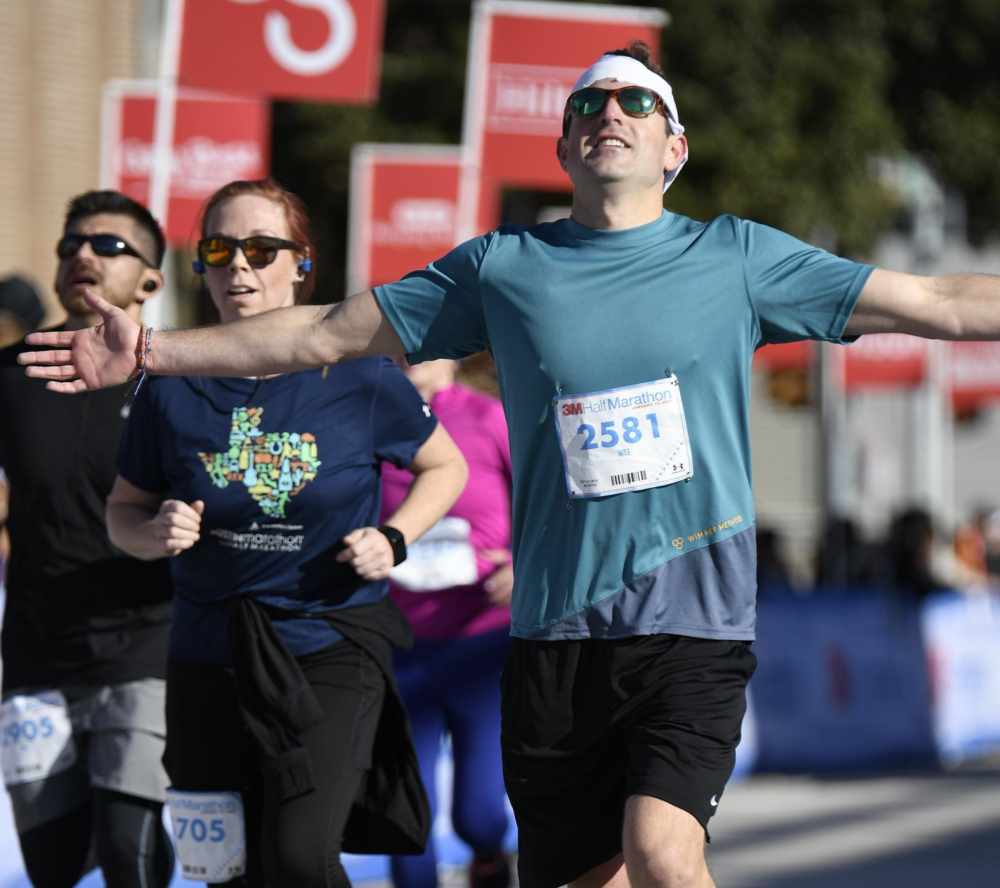Runners can complete these 6 beneficial exercises anytime, anywhere
More and more people are joining the running community. People are attracted by running’s simplicity and numerous health benefits. The best part is, you don’t need fancy equipment, weights, or elaborate training to get into the groove of running. All you need is a pair of shoes. Running is great, but you need to complement it with beneficial exercises that will help you get stronger and reduce the chance of injury. Check out our list of 6 beneficial exercises that will optimize your running workout and prevent injuries. You can do these exercises anywhere, anytime. Pro tip: complement all your exercising with a healthy diet. These 10 delicious recipes are ideal for busy runners.
6 beneficial exercises
-
Squats
 Squats strengthen your quads, glutes, hamstrings, and core. This will help your running form, especially if you recently started running.
Squats strengthen your quads, glutes, hamstrings, and core. This will help your running form, especially if you recently started running.
How to do them
Stand up straight and keep your feet shoulder-width apart. Slowly lower your body while bending your knees. You can use your arms to balance your body. Or you can place your hands behind your head and interlock your fingers. This will make your core work harder. Make sure that your chest is lifted and you’re looking up. Try to go as low as possible and then rise up slowly, while keeping your back straight the entire time. Place your feet side-by-side if you want to increase the level of difficulty.
-
Lunges
 Lunges are great for making your quads, hamstrings, and glutes stronger. They also help with flexibility and improving your range of motion which is important for long-distance running.
Lunges are great for making your quads, hamstrings, and glutes stronger. They also help with flexibility and improving your range of motion which is important for long-distance running.
How to do them
Stand straight and take a step forward with one leg while bending both knees. The knee of the leg that took the step should bend at a 90-degree angle and your other knee should barely touch or hover just above the ground. You can then push back up, take another step with the opposite leg, and complete the entire process. If you don’t have much space, just return to a standing position and repeat with the other leg.
-
Single-leg deadlifts
 One-legged deadlifts help with balance and strengthening your hamstrings and glutes. These are also great if you’re looking for a quick and effective pre-run warm-up.
One-legged deadlifts help with balance and strengthening your hamstrings and glutes. These are also great if you’re looking for a quick and effective pre-run warm-up.
How to do them
Stand straight keeping your body weight focused on one leg. Hold your core tight and lift one leg behind you, while pushing your upper body forward. Lower your body as far as you can, while keeping your back straight. Slowly return to a standing position and repeat with the other leg.
-
Pushups
 Pushups are great for working all upper body muscles and your core.
Pushups are great for working all upper body muscles and your core.
How to do them
Get down on all fours, while keeping your hands and toes wider than your shoulders. Move your legs back from this position so that your body weight is balanced on your hands and toes. Keep your back straight, hold your abs tight and engaged, and slowly lower yourself while bending your elbows. Push yourself back up, while straightening your elbows.
-
Planks
 Planks help strengthen your core.
Planks help strengthen your core.
How to do them
First, enter a pushup position. Focus on keeping your core tight while bending your elbows. Lower your body from this position so that your weight is balanced on your forearms and toes. Try to keep your back straight without sinking. Engage your abs and hold this position for as long as possible. For beginners, 30 seconds is a great start.
-
Burpees
 Burpees help increase endurance and build aerobic capacity. They will work out your entire body.
Burpees help increase endurance and build aerobic capacity. They will work out your entire body.
How to do them
Begin standing up, then squat and place your hands on the floor in front of you. From this position, kick your feet back to a pushup position. Keep your back straight, complete a pushup, and jump back into a squat by kicking your feet forward. Stand up straight and repeat the process.
As you get stronger and become more comfortable with these beneficial exercises, try to increase the difficulty level. You can do more reps, more sets, or increase the amount of time spent doing an exercise. By adding these exercises to your routine, you reduce the chance you experience runner burnout.




 Your purpose for running should not be guided by perceived pressures or mismatched goals. When you train more with less time for recovery, you are at risk for runner burnout. If this happens, the running you loved will no longer feel the same. If you don’t want this to impede your running journey, it is essential to minimize overtraining and maximize your recovery time. Whether you are an everyday runner or a professional,
Your purpose for running should not be guided by perceived pressures or mismatched goals. When you train more with less time for recovery, you are at risk for runner burnout. If this happens, the running you loved will no longer feel the same. If you don’t want this to impede your running journey, it is essential to minimize overtraining and maximize your recovery time. Whether you are an everyday runner or a professional,  Struggling with runner burnout is not easy. It never was. An enjoyable activity can even turn into an unsatisfying chore. Watch for the following indicators. They’ll provide the clues you need to assess runner burnout and act accordingly.
Struggling with runner burnout is not easy. It never was. An enjoyable activity can even turn into an unsatisfying chore. Watch for the following indicators. They’ll provide the clues you need to assess runner burnout and act accordingly. Pushing harder and not slowing down could make the issue worse. Once you identify a few indicators, you need to act quickly. Here are several ways to overcome runner burnout and get back to pounding the pavement.
Pushing harder and not slowing down could make the issue worse. Once you identify a few indicators, you need to act quickly. Here are several ways to overcome runner burnout and get back to pounding the pavement.